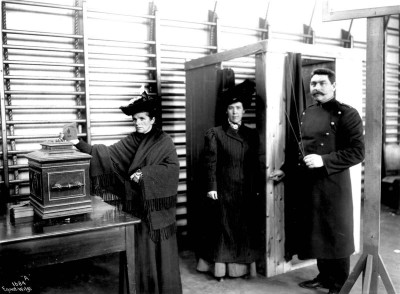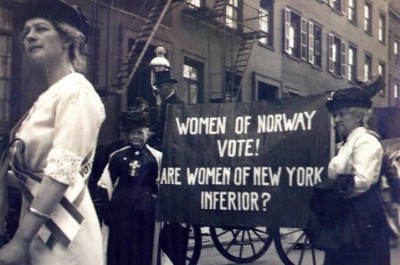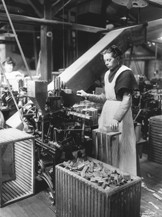Norway is today a world leader in sexual equality and tops international charts for women’s position in the workplace. So it’s surprising to think that it’s only 100 years since Norwegian women were finally granted the universal right to vote, after a political battle that lasted 27 years.

On June 11, 2013 it will be 100 years since women in Norway were finally granted the same rights as men to put their ballot in the ballot box. But to many male opponents at the time, the prospect of women participating in public life was against God’s will, against the Bible, and against their nature. The first suggestion to change the constitution so that women could vote came in 1886, but it took 27 more years before this became a reality for all women in Norwegian society.
To mark the centennial, events are being held up and down the country (external link), including a Women’s Suffrage week in Norway, from June 11-20, and a special “Focus on Democracy” event in the run-up to this fall’s national election that aims to raise awareness and foster commitment to the right to vote, with a view to ensuring that as many people as possible go to the polls on Election Day, September 9.

Parliament (Stortinget) had its first big debate about women being allowed to vote in 1890. A prominent politician for the Conservative Party, Bishop JC Heuch, argued that it was akin to prostitution, and would lead to women losing their identity and even their gender. “She can’t do the work of men, and she won’t do the work of women. What does that make her? It makes her a deformed monstrosity, a thing of no gender,” he argued. Instead of leading to women’s liberation, it would lead to her “degradation, the disturbance of the home, the successive disintegration of the family and a thereby unavoidable moral decline.” Today, his Conservative Party (Høyre) is headed by a woman from Bergen who’s a leading candidate for prime minister, Erna Solberg.
The right to vote (stemmerett) for women also had its (male) champions in Parliament. The left-wing politician Viggo Ullmann asked at the same debate for all the opponents to reflect over the skills and knowledge that their own daughters, wives and mothers had. Bishop Heuch replied: “Just imagine the venerable lady, with her poor falsetto voice, holding forth with all the eagerness and fanaticism that so easily grips women … am I the only one who would have run out of the room in terror, when they think of their mother in such a situation?” Ullmann countered that the only reason women were denied the right to vote was because those in power were scared of losing it.

As part of the centennial celebrations, the Norwegian Folk Museum (Norsk Folkemuseum) in Oslo is holding an exhibition entitled “Devoted Women,” which charts the changes in women’s rights and possibilities in Norwegian society. The exhibition shows that the struggle for women’s rights has not been one straight upward line from 1913 to today. Whereas the generation of Norwegian women before the Second World War continued the fight for women’s rights, most women in the 1950s and 1960s, as a consequence of the war, became housewives. The feminism of the 1970s then came as a backlash to the “housewife era” (husmorperioden).
The struggle for the right to vote was for a long time more about class than gender, notes the exhibtion’s Senior Curator Thomas Walle. He believes that working-class women at the turn of the century felt more solidarity with working-class men, than with upper-class women. For a long time, men without property were also denied the vote, and the right to vote was only granted to all adult men in 1898, 15 years before it was extended to women.
When women experienced the victory, in 1901, of being allowed to vote in local elections (kommunevalg), it only applied to those women who paid tax over a certain level or were married to someone who did. This meant that around 230,000 women could vote, equivalent to about 42 percent of the female population over 25 at the time. In Norwegian society in the 1900s many working-class women were employed in factories or in service, and they were still denied the right to vote.
Could ‘lead to sickness’
In 1907, stemmerett for women was debated again in Parliament. Doctor and veterinary surgeon Ole Olsen Malm expressed his concerns about forcing women to participate in the “maelstrom of public life.” He gave his medical view that “strong brain work does not just cause indisposition in women, but leads directly to sickness in her,” and that the best way to help women was to improve the living conditions of men, thereby guaranteeing that as many women as possible could have a carefree marriage.
Victory came again in the same year, 1907, when women were allowed to vote in general elections (stortingsvalg) for the first time. This right, however, still depended on their own or their husband’s income. In 1910 they were granted the same voting rights as men in local elections, and in 1911 women’s rights activist Anna Rogstad became the first-ever female Member of Parliament in Norway. The event was apparently met with great public attention, and people who could not fit into the viewing galleries gathered outside the Parliament building (Stortinget).
Constitutional amendment
And two years later, on June 11, 1913, Norway’s written constitution (Grunnloven) was finally changed to state that “The right to vote is for all Norwegian citizens, both men and women, who are 25 years or over, and who have lived in the country for at least five years and will continue to live there.” This time the mood had changed and no one spoke out against it in the debate, with all members voting in favour of the proposal. All women now also had the right to be elected to Parliament, or to the local council. Norway was one of the first countries in the world to grant universal suffrage to women, after New Zealand (1893), Australia (1902) and Finland (1906).
Norway was recently voted at the second-best country in the world for women to work in (after New Zealand) but the number of women in top leadership roles is still relatively low. The proportion of women in Parliament is high at 40 percent but at the local level, barely one mayor in four is a woman. Around 40 percent of women as opposed to 12 percent of men work part-time, and women’s hourly pay is on average around 85 per cent of men’s hourly pay, although the pay gap is now reported to be slowly closing (statistics from the Ministry of Children, Equality and Social Inclusion). Some women, particularly immigrants, face exploitation or even sexual harassment in Norway today in poorly paid service jobs such as au pairs.
Views and News from Norway/Elizabeth Lindsay
Please support our news service. Readers in Norway can use our donor account. Our international readers can click on our “Donate” button:

